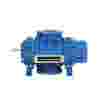How much airflow do blowers provide?
Blowers are capable of generating large amounts of airflow, making them suitable for applications requiring high air movement, such as hydro-excavation.
What is the noise level of blowers during operation?
Blowers can be quite noisy compared to other types of pumps. Noise levels vary based on the specific design and application, but they generally produce more sound than rotary vane or liquid ring pumps.
For which jobs can I use these pumps?
Blowers are ideal for hydro-excavation trucks and are used in applications requiring significant airflow, such as soil removal, debris extraction, and industrial vacuuming.
Are there any hazardous emissions?**
Blowers themselves do not produce hazardous emissions, but they can stir up dust and other particulates. Proper filtration and dust control measures should be implemented to ensure safe operation.
Blowers are a critical component in the vacuum pump industry, particularly for applications requiring extensive airflow. While they come with some challenges such as higher costs, complexity, and noise, their ability to move large volumes of air makes them indispensable for tasks like hydro-excavation. Understanding how blowers work and how to troubleshoot common issues can help maintain their performance and extend their lifespan.
More Questions?
Have more questions? We're happy to help! Call us at (844) 442-4692 or send us a form by clicking Contact Us and we'll answer all your blower questions!

